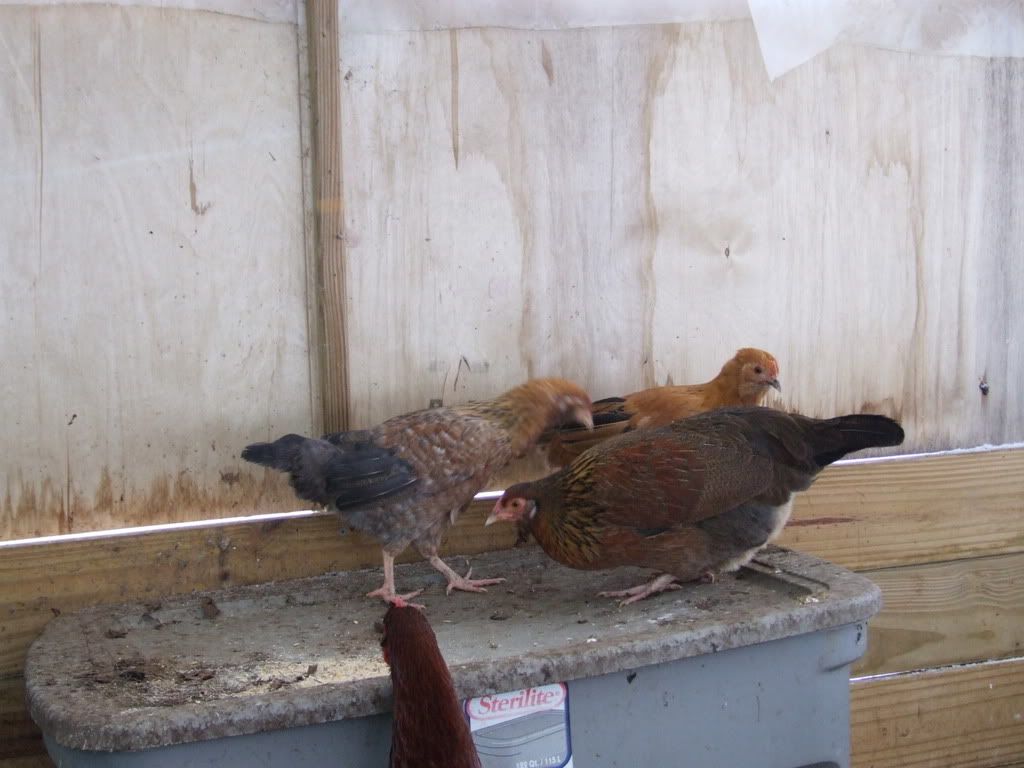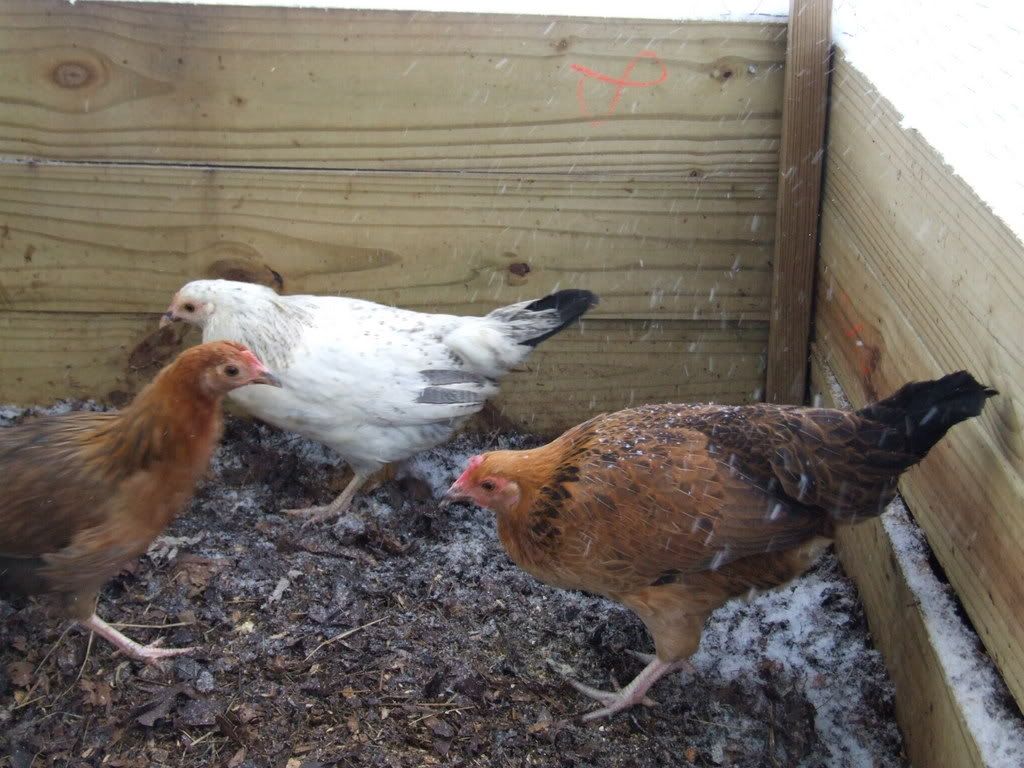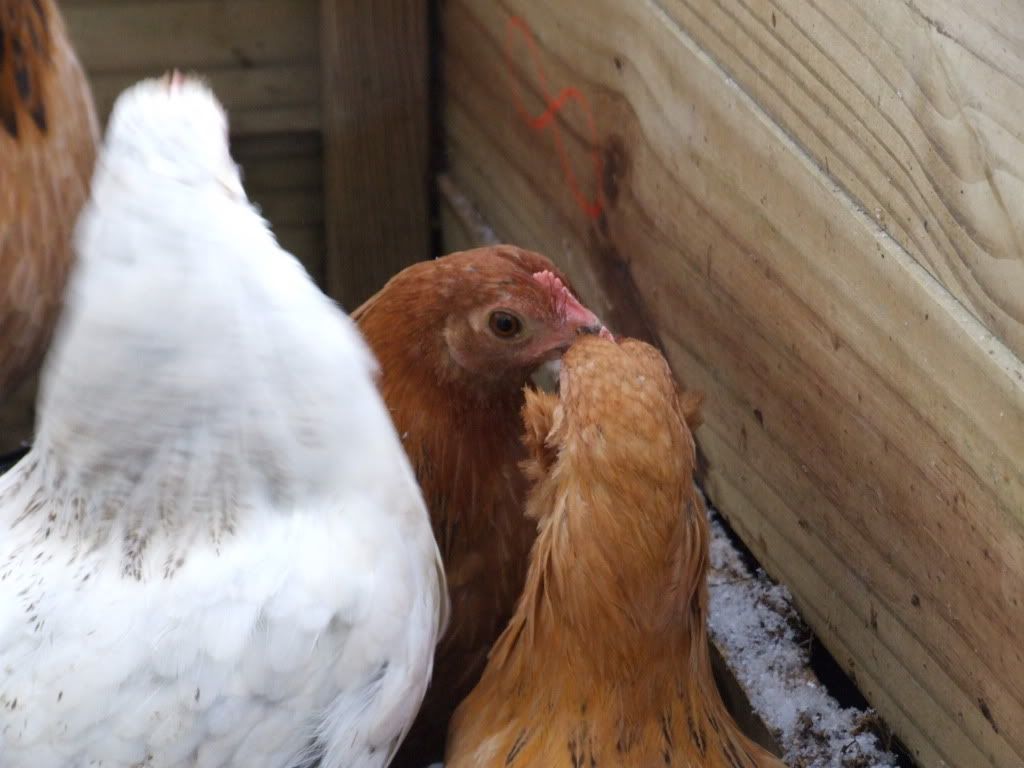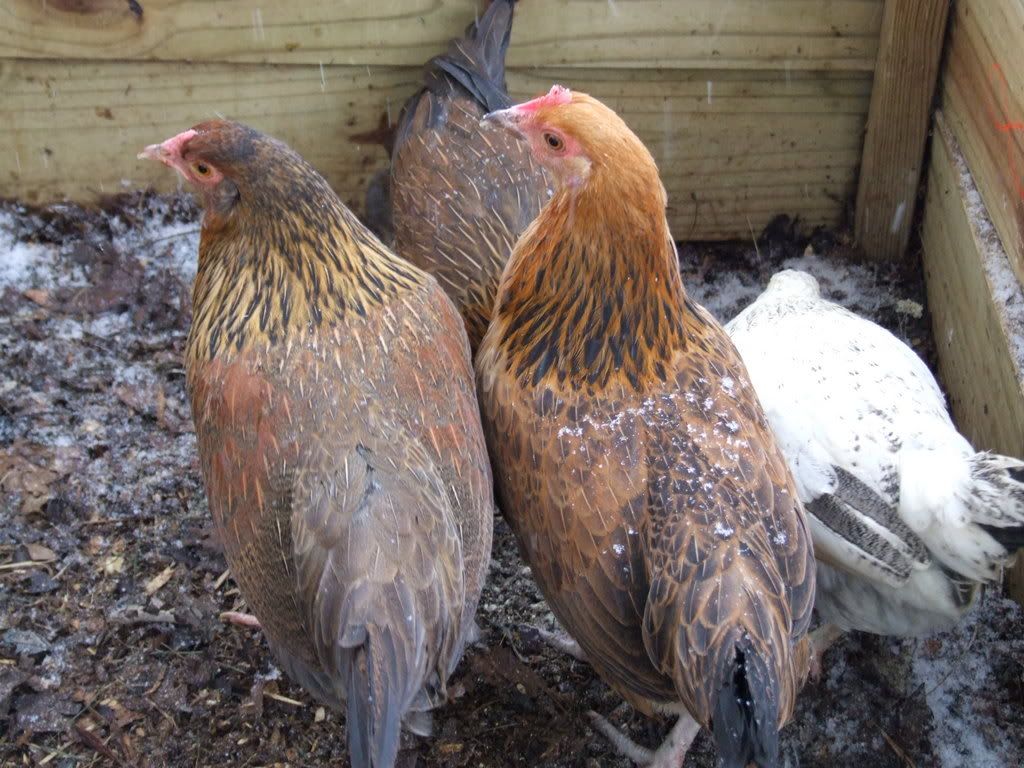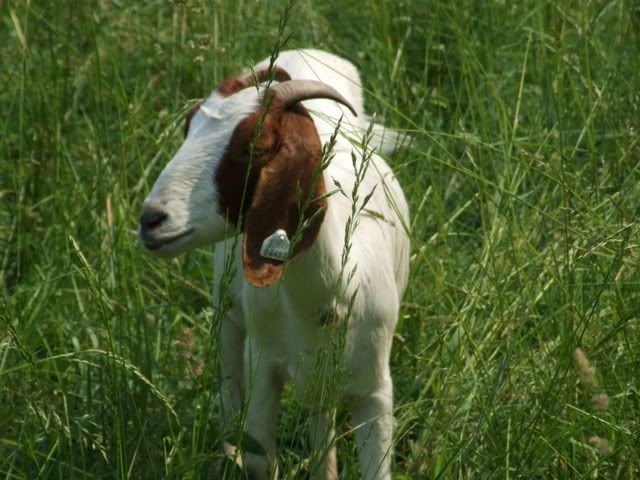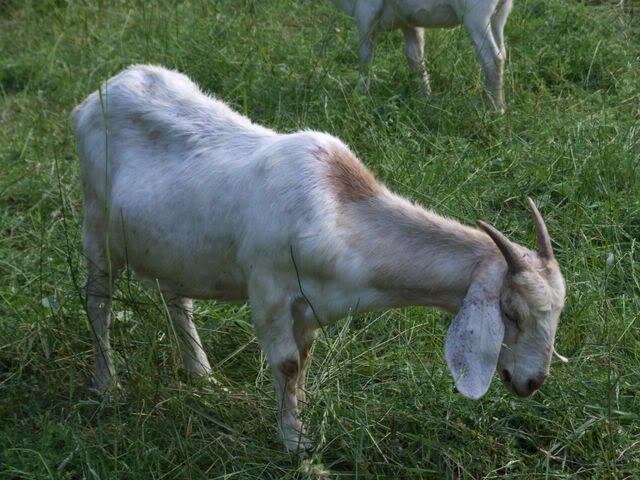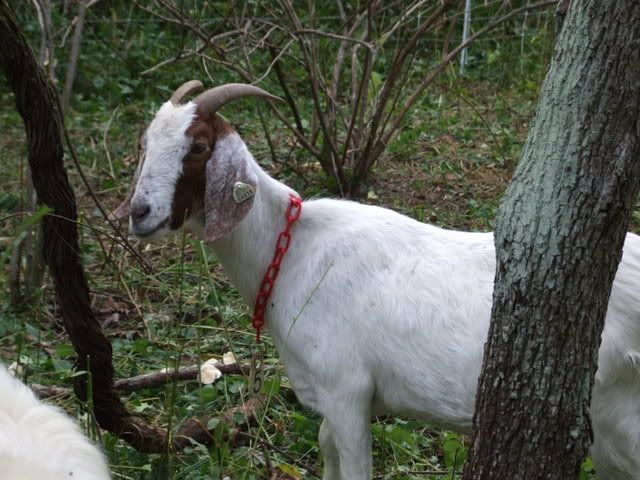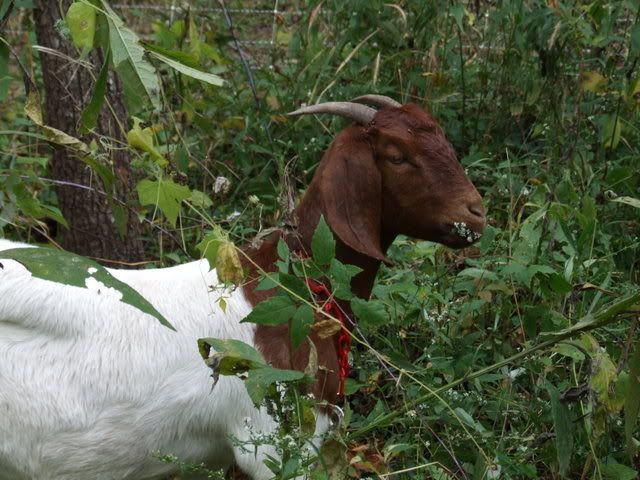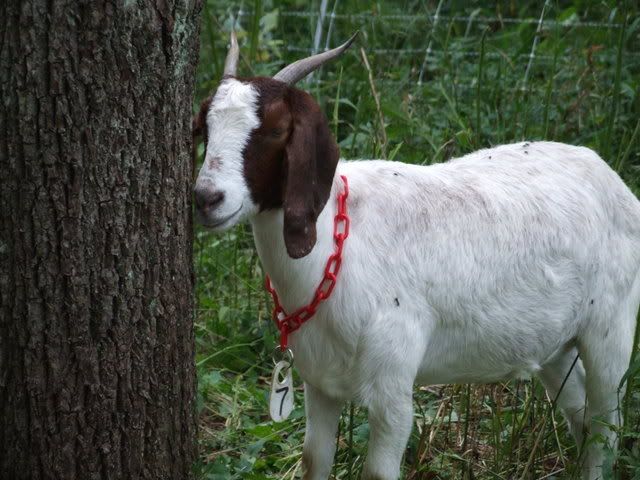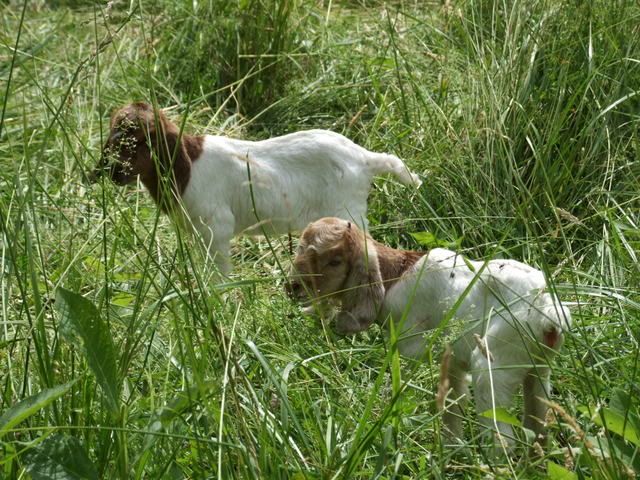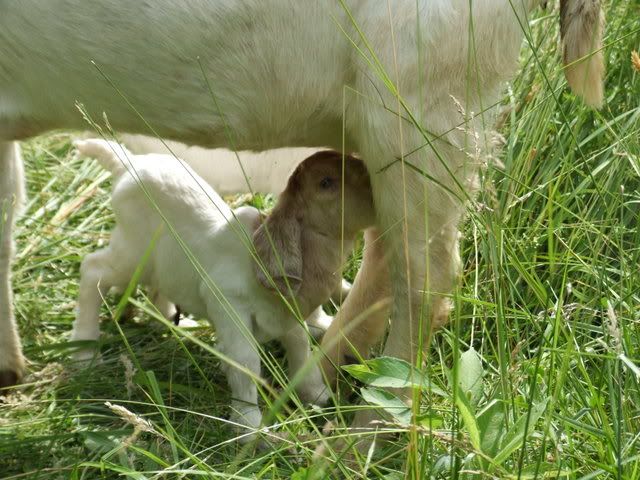Monday morning, I found Swellendam lying on the ground, unable to get up, and twitching her legs. I managed to get a vet out to look at her that afternoon. I had tried searching the internet for her symptoms, but the closest thing she matched was enterotoxemia, which didn't make much sense. I don't feed grain, and the goats had been eating pretty much the same forage as ever. Doctor Sparling took one look at her and diagnosed brain worms, which he said came from deer. He recommended fenbendazole (Safe-Guard), but said that her chances of recovery were very low. I had figured as much, since she was pretty far gone. He was unable to tell me the name of the parasite, which I'd never seen mentioned before, so I did some research after I got home.
Paralaphostrongylus tenuisCalled meningeal worm, brain worm, and deer worm, P. tenuis normally completes its life cycle in white-tailed deer. The adult parasite lives in the brains of deer, where it lays its eggs. The eggs travel through the blood to the lungs, where they hatch into larva. The larva travel to the throat, where they are swallowed and passed in the feces of the deer. Here's where things get a little bit strange. The first-stage larva in the feces are not infective until they are consumed by terrestrial snails or slugs. The larva transform into infective third-stage larva within the gastropods, with warm weather allowing them to change more quickly. Then, when a white-tailed deer ingests an infected gastropod while browsing, the larva travel to the brain and mature into adults, starting the cycle over again. The parasites generally cause no harm to white-tailed deer.
Other ruminants can be susceptible to brain worm if they eat infected snails or slugs. However, once the larva migrate into the brain, they are unable to mature into adults. Thus, they swim around in the brain and spinal cord and cause increasing neurological damage. In some cases they will travel from the spinal cord into the skin, causing itching so intense that the animal will chew holes in its hide. The camelids (llamas and alpacas) seem to be more susceptible than goats and sheep.
Since the parasite requires both deer and gastropods to complete its life cycle, only areas with high concentrations of white-tailed deer and a humid climate are at risk. There is some research showing that the instances of the disease peak three to four months after each peak gastropod season. In the Ohio River Valley, the observed peaks of disease are September/October and January/February. This corresponds to the peaks of gastropod prevalence: spring and fall.
DiagnosisThere is no way to definitively diagnose brain worm in a living animal. The only way to know for sure is to find the larva in the nervous symptom. The symptoms include lameness or weakness, paralysis, circling, blindness, and other signs of neurological distress. Some animals may recover without intervention, but even if the brain worms are destroyed, the neurological damage remains.
TreatmentThere really isn't a lot of research yet on treatment for acute cases. The most common regimen seems to be dewormers to kill the larva (although there is no reliable information on which, if any, of the dewormers will cross the blood/brain barrier), steroids to reduce the inflammation while the dewormers work, and supportive care.
PreventionSince the parasite requires gastropods as intermediate hosts, one method of prevention consists of keeping the livestock away from moist areas and woodlands. However, goats much prefer browsing in woodlands and brushy areas to grazing in pastures, and pasture grazing puts goats at much greater risk for stomach worms.
Another possibility for small farms is to put up deer-proof fencing around the property. This is of course extremely expensive, and it wouldn't prevent infected gastropods from entering. Some people spray poisons designed to kill snails and slugs to prevent the disease.
Probably the most common method of prevention is deworming every month, so that the brain worm larva never make it to the nervous system. However, there is no dewormer that is specifically for P. tenuis, so they use the standard dewormers. Deworming on such a frequent basis rapidly leads to resistant strains of parasites, many of which are a greater threat to goats than the brain worm itself.
For now, I will be deworming every month with fenbendazole, but this is only a temporary solution. I can't afford to lose anymore goats right now, but I do want to develop a management system that will not require the use of chemical dewormers on a frequent basis.
Possible Natural Prevention StrategiesThe most obvious strategy (to me anyway) would be to choose breeding stock that are naturally resistant to this and other parasites and diseases. I understand that this is how the Kiko breed of goats was developed: a large number of goats were kept with no intervention, and the ones that survived, bred. As a sole strategy, this only works if you have a very large starting breeding pool and don't mind losing a large percentage of the early generations. However, in combination with other management strategies, I think that breeding for animals that require less intervention is a good long term strategy.
There are some natural dewormers out there, although as far as I know there has been no in-depth research as to their effectiveness. Some people swear by diatomaceous earth (DE), which is used as a natural way to kill many kinds of insects/arachnids. The sharp edges of the DE cut open the carapace of the insect, and it dries out and dies. I don't quite understand how DE kills parasites in the moist environment of the digestive track. I suppose that it might kill the larva in the feces once they are exposed to air, which would prevent reinfection. If this is the case, it would not prevent brain worms since they are only passed by infected deer.
There are also herbal dewormers, which often contain wormwood. Again, there is little to no research on the efficacy of these products. However, since the standard chemical dewormers work on brain worms, it's possible that if herbal dewormers work at all, they probably would work on brain worms as well.
Another strategy would be to use natural methods to control the gastropod population. There's a saying, "There's no such thing as a surfeit of snails, only a dearth of ducks." I think that turning ducks into a paddock to clean up the snail and slug population could be a very effective way to control brain worm in livestock. Especially if paddocks are kept small, so that gastropods from neighboring paddocks won't have a chance to migrate in before the animals are moved again.
I had planned to introduce Muscovy ducks next year anyway, to help control the fly population. I'll just add in some mallard-derived breeds as well to help with the gastropods. The original plan was to have the Muscovies follow the goats, but now obviously the Duck Brigade would have to precede the goats into any paddock. It would probably also be a good idea to keep a few of them with the goats as well. I know this will open up new hazards, such as coccidiosis, to the goats. I'll just have to see how it works out in practice.
So, to sum up, this fall I will deworm my goats with fenbendazole monthly until February. As soon as the weather begins to warm up in the spring, I will introduce several breeds of ducks into the paddocks to eat up all the snails and slugs. Under this system, there will still be some risk of brain worm, but it should be greatly mitigated. The long term plan is to select for resistance to all diseases and parasites. I'll probably also introduce some Kiko bloodlines into my herd to help speed that process up.
Poor Swellendam didn't make it, but at least now I know about a significant risk in my area, and can take steps to prevent further problems. RIP Swellendam; you were a good goat.
Sources:Meningeal Worm, by Susan ShoenianParelaphostrongylus tenuis in the Ohio River Valley and Parasitology in Llamas and Alpacas, by Cliff MonahanPrevention of Meningeal Worm Infection
